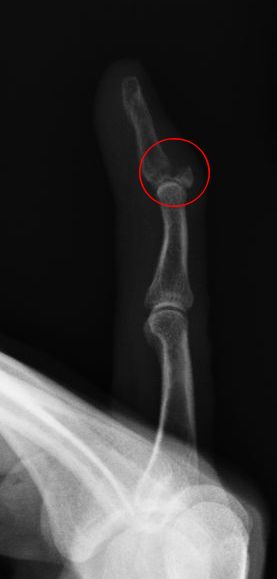Busch fracture
Editor-In-Chief: Prab R Tumpati, MD
Obesity, Sleep & Internal medicine
Founder, WikiMD Wellnesspedia &
W8MD medical weight loss NYC and sleep center NYC
| Busch fracture | |
|---|---|
 Mallet finger, a type of avulsion fracture | |
| Synonyms | Mallet finger fracture |
| Pronounce | N/A |
| Specialty | Orthopedic surgery |
| Symptoms | Pain, swelling, inability to extend the distal phalanx |
| Complications | Chronic pain, arthritis |
| Onset | Sudden, following trauma |
| Duration | Varies, weeks to months |
| Types | N/A |
| Causes | Trauma to the finger |
| Risks | Sports, manual labor |
| Diagnosis | Physical examination, X-ray |
| Differential diagnosis | Jersey finger, finger dislocation |
| Prevention | N/A |
| Treatment | Splinting, surgery |
| Medication | NSAIDs for pain |
| Prognosis | Good with treatment |
| Frequency | Common in sports injuries |
| Deaths | N/A |
Busch Fracture[edit | edit source]
A Busch fracture is a specific type of avulsion fracture that occurs at the base of the distal phalanx of a finger. This injury is often associated with a condition known as mallet finger, which results from the disruption of the extensor tendon at the distal interphalangeal joint.
Mechanism of Injury[edit | edit source]
The Busch fracture typically occurs when an external force is applied to the tip of the finger, causing the distal phalanx to flex suddenly while the extensor tendon is under tension. This forceful flexion can lead to the avulsion of a small fragment of bone at the tendon insertion site. The injury is common in sports such as baseball, basketball, and volleyball, where the fingers are frequently exposed to sudden impacts.
Clinical Presentation[edit | edit source]
Patients with a Busch fracture typically present with pain, swelling, and an inability to extend the distal phalanx of the affected finger. The finger may appear to droop at the distal interphalangeal joint, a characteristic sign of mallet finger. The injury is often accompanied by tenderness at the site of the fracture.
Diagnosis[edit | edit source]
Diagnosis of a Busch fracture is primarily based on clinical examination and confirmed with radiography. An X-ray of the affected finger will reveal the avulsion fracture at the base of the distal phalanx. It is important to assess the size of the avulsed fragment and the degree of joint subluxation, as these factors can influence treatment decisions.
Treatment[edit | edit source]
The treatment of a Busch fracture depends on the size of the avulsed fragment and the degree of joint involvement. Non-surgical management is often preferred, especially for small fractures without significant joint subluxation. This typically involves splinting the distal interphalangeal joint in extension for a period of 6 to 8 weeks to allow for proper healing of the tendon and bone.
In cases where the fracture fragment is large or there is significant joint subluxation, surgical intervention may be necessary. Surgical options include open reduction and internal fixation or the use of specialized splints to maintain joint alignment during healing.
Prognosis[edit | edit source]
With appropriate treatment, most patients with a Busch fracture can expect a good functional outcome. However, some may experience residual stiffness or a slight extension lag at the distal interphalangeal joint. Early diagnosis and adherence to treatment protocols are crucial for optimal recovery.
See also[edit | edit source]
Search WikiMD
Ad.Tired of being Overweight? Try W8MD's physician weight loss program.
Semaglutide (Ozempic / Wegovy and Tirzepatide (Mounjaro / Zepbound) available.
Advertise on WikiMD
|
WikiMD's Wellness Encyclopedia |
| Let Food Be Thy Medicine Medicine Thy Food - Hippocrates |
Translate this page: - East Asian
中文,
日本,
한국어,
South Asian
हिन्दी,
தமிழ்,
తెలుగు,
Urdu,
ಕನ್ನಡ,
Southeast Asian
Indonesian,
Vietnamese,
Thai,
မြန်မာဘာသာ,
বাংলা
European
español,
Deutsch,
français,
Greek,
português do Brasil,
polski,
română,
русский,
Nederlands,
norsk,
svenska,
suomi,
Italian
Middle Eastern & African
عربى,
Turkish,
Persian,
Hebrew,
Afrikaans,
isiZulu,
Kiswahili,
Other
Bulgarian,
Hungarian,
Czech,
Swedish,
മലയാളം,
मराठी,
ਪੰਜਾਬੀ,
ગુજરાતી,
Portuguese,
Ukrainian
Medical Disclaimer: WikiMD is not a substitute for professional medical advice. The information on WikiMD is provided as an information resource only, may be incorrect, outdated or misleading, and is not to be used or relied on for any diagnostic or treatment purposes. Please consult your health care provider before making any healthcare decisions or for guidance about a specific medical condition. WikiMD expressly disclaims responsibility, and shall have no liability, for any damages, loss, injury, or liability whatsoever suffered as a result of your reliance on the information contained in this site. By visiting this site you agree to the foregoing terms and conditions, which may from time to time be changed or supplemented by WikiMD. If you do not agree to the foregoing terms and conditions, you should not enter or use this site. See full disclaimer.
Credits:Most images are courtesy of Wikimedia commons, and templates, categories Wikipedia, licensed under CC BY SA or similar.
Contributors: Prab R. Tumpati, MD




